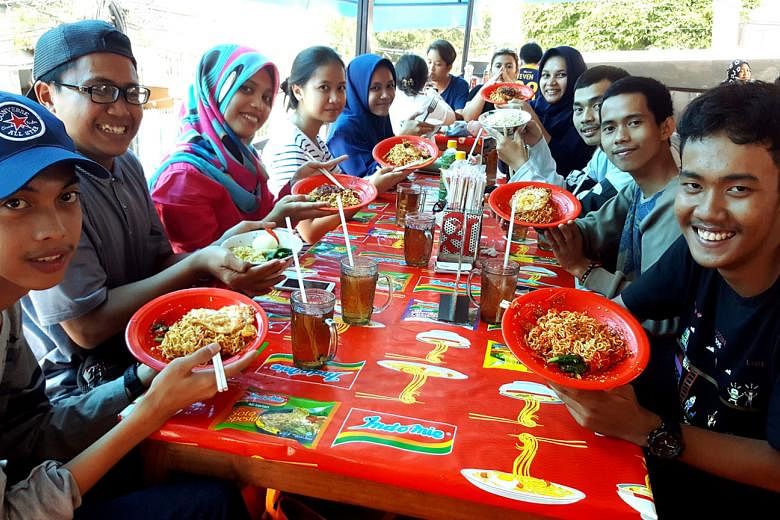JAKARTA • A sarong-clad man stands on a clifftop and sings with gusto the opening lines of a famous Indonesian instant noodle TV commercial.
"From Sabang to Merauke...," he croons, referring to two well-known cities at either end of the archipelago. "Flavour choices may differ, but we are single-hearted on taste."
Carefree children, businessmen in suits, hard-working farmers and trendy teenagers then slurp bowls of the piping-hot noodles as the song comes to its soaring conclusion: "Indomie, our taste."
The commercial effectively sums up Indonesia's near-universal love for Indomie, a popular brand which has become synonymous with instant noodles in the country.
And the humble dish is big business in the country of 261 million: Indonesia is the world's second-largest consumer after China, devouring 13.2 billion packets last year, according to the World Instant Noodles Association.
"Forget rendang or nasi goreng; Indonesia's real national food is instant noodles. There must be a packet or two in every kitchen here," said 18-year-old student Putri Aulia.

Dressed up or down, enjoyed at home or at warungs (eateries) for breakfast or late-night supper, Indonesians take their instant noodles seriously.
With prices starting from as low as 20 Singapore cents a packet, they are the go-to food for college students who live far from their families, office workers looking for a quick meal after work, and even the late president Suharto, who reportedly asked the palace chef to cook them for him and had even served them to guests.
First produced in Indonesia in the 1960s, instant noodles entered kitchens nationwide due to natural disasters, Mr Sribugo Suratmo, chairman of the Association of Bread, Biscuit and Instant Noodle Producers, told The Straits Times.
"Indonesia experiences a lot of natural disasters. When that happens, food aid is always in the form of instant noodles," said Mr Sribugo.

"Factories are able to produce instant noodles fast enough to meet unexpected spikes in demand. That's why noodle consumption is especially high in Indonesia, compared to other countries," he said.
The launch of Indomie by Indofood Sukses Makmur in 1982 took things to the next level through mass production and widespread sales, even in remote areas.
In a country where 40 per cent of the population live on less than US$2 (S$2.80) a day, the cheap and easy-to-cook dish soon became a staple. And with dozens of factories across Indonesia churning out an ever-growing variety of flavours, and street stalls everywhere offering the fare, experts expect consumption to grow up to 10 per cent this year, to 15 billion packets.
But while nature and economics launched instant noodles in Indonesia, it is innovation and marketing savvy that will ensure the staying power of the humble meal.
CHEAP EAT GETS HIP
From Indomie Gourmet (seaweed and corned beef flavour) and Indomie Pizza (smoked beef and Bombay onions) to Indomie Singapore Chilli Crab, the menu of instant noodle meals seems endless at hipster cafes such as Warunk Upnormal and What's Up Cafe.
Similar joints specialising in instant noodles have sprung up in downtown Jakarta in the last three years.
"Instant noodles are the 'food of a million followers'. Indonesians just love to eat them. I have been asked to open more outlets in various provinces," Mr Valentino Ivan Lie, 35, owner of What's Up Cafe where the noodles are priced at $2 per plate, told The Straits Times.
Mr Lie said he has opened nine outlets in Jakarta, Bekasi, Depok and Bandung in the past year, and plans to open at least 100 more in the next five years, including in Singapore.
At Goedkoop, a Dutch theme coffee shop whose name literally means cheap and good, the high-sodium and high-fat junk food gets a dash of wholesomeness in the form of Indomie Gourmet - noodles cooked in clear chicken-flavoured broth and topped with egg, nori, spinach and corned beef.
"Instant noodles are a must-have in any coffee shop. I grew up with it, and when studying abroad, that's the one thing I would eat if I missed home," said one of its founders, Ms Thanya Ponggawa, who lived in the United States for five years.
Some businesses are cashing in on the craze, selling unique noodles instead of other types of food.
Ms Sri Gusni Febriasari,who owns Mix Diner & Florist, sells 200 to 350 bowls daily of her signature Mie Mirip, or "Lookalike Noodles": instant noodles prepared and garnished to look exactly like photos on their packaging.
"Whenever we buy a packet of instant noodles, don't we look at the packaging and wish we could eat an exact copy?" she said.
In the age of YouTube and Instagram, instant noodles have developed a following on the Internet.
A video featuring London-based chef Ben Sumadiwiria's tongue-numbing experience at a Jakarta stall known for a particularly spicy version of instant noodles has attracted nearly 300,000 views since it was posted in August.
Mr Sumadiwiria, who owns a cooking show channel called Awesome Eats On YouTube, told The Straits Times he has at least 30 packets stashed in his suitcase at all times.
"Instant noodles are life. I eat them all the time!" said the 22-year-old.
The video is just one among hundreds posted online by instant noodle fans.
-
'Death' by instant noodles
-
The Indomie Pedas Mampus indeed lives up to its name.
The first few forkfuls were hot but not lethal, or so I thought as I sank my teeth into a mouthful of the Death Spicy noodles - packed with the punch of an estimated 100 chilli padi.
Stinging heat gushed through every nerve on my tongue and spread upwards to my nose and temples. My head throbbed, my ears popped and my eyes exploded with tears.
My pores oozed sweat and my skin itched. I rubbed my Angelina Jolie-esque lips and exhaled clouds of hellfire before popping a candy to douse the burn.
Mr Sartono, the 54-year-old owner of the Warung Abang Adek eatery, had warned me that some people fainted after eating the stuff while others had to be taken to hospital.
I only had diarrhoea for the rest of the day and had to gulp coconut juice and pop a painkiller to stop the cramps.
Arlina Arshad
A group of young Indonesian rappers called SkinnyIndonesian24 sang in a video which has since attracted nearly 4.4 million views: "Indomie. Noodles from Indonesia. If you are hungry, don't despair. The solution is cheap. The taste is insane."
THE NEXT REVOLUTION
The dish is going luxe, with the development of higher-quality noodles and better ingredients.
"Instant noodles will remain as emergency food during natural disasters, but will also incorporate new innovations using real meat and vegetables," said Mr Sribugo.
Home-grown noodle makers are also expanding their reach overseas, while foreign ones are selling their noodles in Indonesia as well as partnering local experts to develop new flavours.
Indofood Sukses Makmur, which controls over 70 per cent of the market, has set up noodle factories in Malaysia, Saudi Arabia and other countries.
Last year, the company reportedly began building what is expected to be the biggest factory outside Indonesia in Morocco. Two months ago, it opened a factory in Serbia.
Food consultant William Wongso said he spent the past year helping Japan-based Nissin Foods to develop four signature flavours - Malay chicken stew, savoury spicy seafood, classic oxtail and Indonesian tom yum - to be exported to Japan.
"The middle-income group is growing and is willing to pay for premium noodles, combining Japanese high-quality noodles with rich Indonesian flavours ," he said.
"But that's just a teaser, not a replacement. You must still come to my country to taste the real thing."



